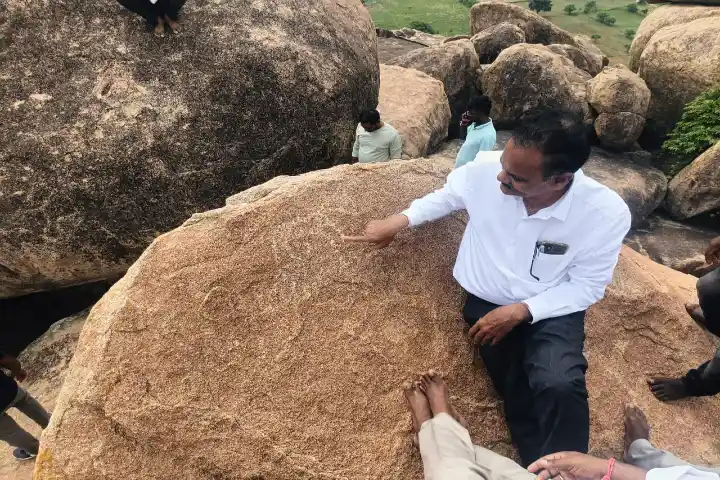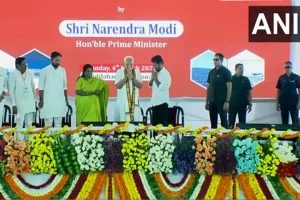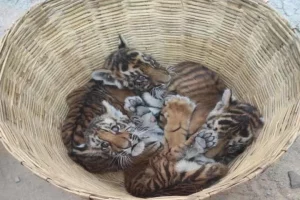A group exploring Moosapet suburb, which is part of Greater Hyderabad in Mahaboobnagar district of Telangana for developing the hill as a spiritual centre and tourist spot, has made a startling discovery. They came across a rock bruising of a bull which dates back to the early phase of the Neolithic period, that is 4,000 years old.
Dr. E. Sivanagireddy, a noted archaeologist, CEO of Pleach India Foundation and part of the team was exploring the hillock called Ramaswamy Gutta and while examining superstructure built with brick over the Ramalingeswara temple, he made this find. Talking to India Narrative he disclosed: “It is a rock bruising of the bull along with a few figurines of men and animals below it delineated using stone tools. The art form denotes the early phase of the Neolithic period in which man was domesticating animals and practicing agriculture.”
On being asked by India Narrative to explain what bruising means he said: “It is a technique of hitting on the surface of a rock with a stone object and/or implemented to deliberate a shape by the prehistoric people from the Mesolithic period. It has been made at a height of 400 feet from the ground level and the bull figure measures 10 cm x 8 cm in length and width.”
Elaborating why it dates back to Neolithic period for India Narrative he said: “Neolithic period is characterised by domestication of animals, intensification of agriculture and using polished stone tools and expression of inner urge through rock paintings, bruisings and terracotta figurines. Such paintings and bruisings are noticed at many Neolithic, Neolithic-Chalcolithic and Megalithic (Iron Age) periods attested by C-14 dating. Based on that basis of stone tool typology and art works, we give random dating for such findings in the absence of radiocarbon dating. The Neolithic period in South India ranged between 4000 BCE to 1750 BCE. Hence, I ascribed 4,000 years to the art form I noticed at Moosapet.”
Apart from the bull and men, other animals also form part of this art work. This clearly reflects the age and the time in which they were carved out. “The figure of bull and other animals like deer and buffaloes and men denote the environment and ecosystem in which the people execute such artworks based on their experience and observations. The rock bruising reveals the lifestyle of the period particularly agrarian,” the historian told IN.
Dr. Sivanagireddy fervently appealed to the local people to preserve the archaeologically important prehistoric rock art form for posterity and to make suitable scaffolding arrangements for the visitors to access it for a comfortable view. He said further investigation of the area is needed to see if some more artworks are present.
On being asked by India Narrative, if any similar works have been found earlier in this region he said: “Similar art works are reported from Tatikonda, a nearby village in the same district.”
The team was surveying the area to prepare a masterplan for development of the entire hill as a spiritual centre, an ecotourism spot and heritage tourism destination. Others who were part of the team included Chandrsekarchetty, Visveswar, Bhaskar Goud, Kondaiah and Sthapathi B. Venkatreddy.
Also read: 12th Century Chalukya inscription sheds light on donations made to Lord Shiva temple




















